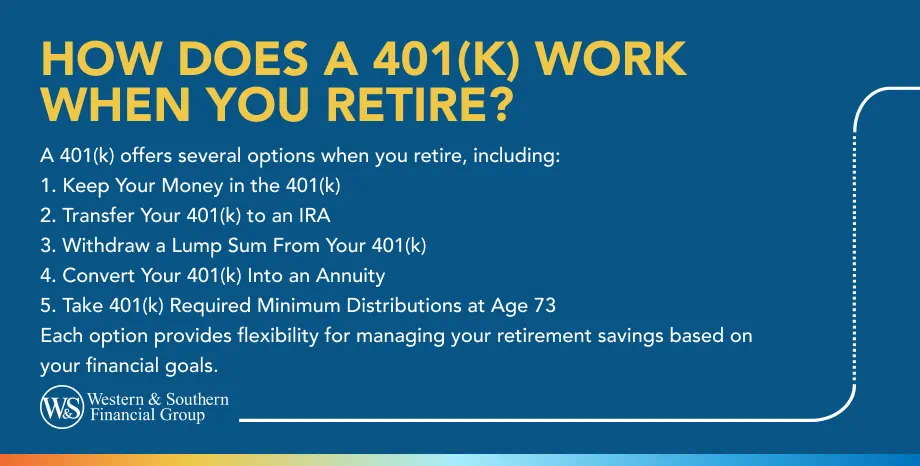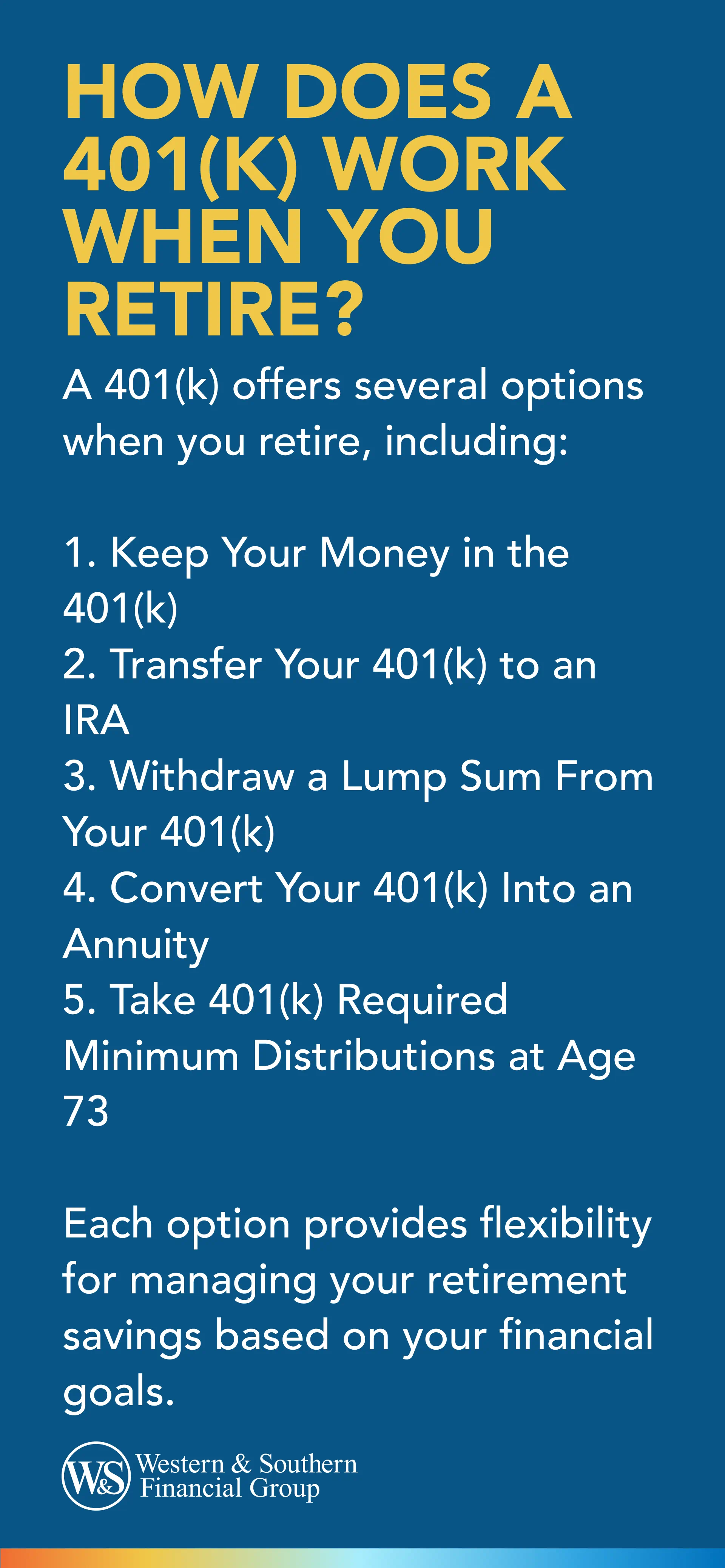Table of Contents
Table of Contents


Key Takeaways
- Upon retirement, choose to leave your 401(k), transfer it, withdraw a lump sum, convert it, or take RMDs at 73.
- Consider your income needs, other sources, and existing investments before deciding on your 401(k).
- Watch for tax implications and penalties with different withdrawal options, like lump sums or Roth withdrawals.
- Take your time and use tools like calculators or professional advice to decide on your 401(k).
- Keep an investment mix that fits your goals and risk tolerance, and avoid quick changes without a plan.
If you're curious about what to do with your 401(k) after retirement or wondering how a 401(k) works when you retire, you'll be happy to know that there are plenty of options and insights available. But before you begin planning how to turn your accumulated wealth into a retirement income stream, it's important to fully understand those options.
Whether your retirement is years or decades away, it's never too early to learn more about your 401(k) choices. Here's what to know.
5 Options for Using Your 401(k) When You Retire
The options you have associated with your 401(k) after you retire are the same as any other 401(k) participant who terminates employment. In IRS terminology, this is called "separation from service," which refers to any reason for leaving your job — whether you quit, got laid off or retired.
After a 401(k) participant separates from service, they have several options for their 401(k) savings. Here are five options and IRS rules to specifically be aware of.
1. Keep Your Money in the 401(k)
If your account balance is at least $5,000, you generally can leave your money in your 401(k) after retirement. This may be a good idea if you like the plan's investment funds. Keep in mind that once you are no longer on the payroll, you will no longer be able to make new contributions to your 401(k).
2. Transfer Your 401(k) to an IRA
After you retire, you may transfer or rollover the money in your 401(k) to another qualified retirement plan, such as an individual retirement account (IRA). This may be a good idea if you're looking for more investment options. To transfer your 401(k) to an IRA, you can request either a direct rollover or a 60-day rollover.
- Direct Rollover: You can request that your employer transfer your 401(k) assets directly to the investment company that manages your IRA. A direct rollover is a tax- and penalty-free transfer.
- 60-day Rollover: If a distribution from your 401(k) is paid directly to you, you have 60 days to deposit all or a portion of it into your IRA. Taxes are withheld from the distribution, which means you'll have to come up with additional money to roll over the full amount of the distribution.
3. Withdraw a Lump Sum From Your 401(k)
You have the option of withdrawing all or a portion of your 401(k) balance after retirement. Keep in mind that withdrawals from your traditional (pretax) 401(k) contributions will be taxable as income.
Under 59½ years old, a 10% early withdrawal penalty generally applies regardless of contribution type. However, once you reach age 55, if you retire, the 10% early withdrawal tax does not apply.
4. Convert Your 401(k) Into an Annuity
Although this option is not widely discussed, 401(k) plans may offer the option to convert the savings into an annuity. This option is typically called an immediate annuity, which converts a lump sum 401(k) balance into an income stream of monthly payments right away. The income payout is guaranteed, but this form of income may not be appropriate for all retirees. Keep in mind that guarantees are based on the claims-paying ability of the issuer. Additionally, there could be consequences related to such a conversion, like losing access to principal in case of emergencies and potentially receiving less than the principal amount back through annuity payments due to death.
5. Take 401(k) Required Minimum Distributions at Age 73
Similar to a traditional IRA, the IRS requires you to take minimum distributions from traditional (pretax) contributions made to your 401(k). You generally have to start taking your required minimum distributions (RMDs) by age 73. If you decide to leave money in your 401(k) after you retire, it's important to incorporate RMDs into your retirement plan to account for this income.
The RMD amount depends on your age, the year of withdrawal and the balance of your retirement account as of the end of the previous year. With this information, the IRS uses a life expectancy factor to determine the exact amount of your RMD for the given year. To get an idea of these calculations, you can use an IRS RMD worksheet or an online RMD calculator.1
How to Decide What to Do With Your 401(k) After Retirement
After you retire, the basic choices you'll have with your 401(k) are to keep the money in the plan, transfer your 401(k) money to another qualified retirement plan (such as an IRA) or withdraw all or a portion of your 401(k) balance. While these options are relatively simple, deciding what's right for you and your retirement goals depends on multiple factors and may require considerable thought and planning.
Some points to consider include other investments or retirement accounts you have outside of your 401(k) plan, whether you made traditional or Roth contributions and if you'll be earning other sources of income, such as part-time work, pensions or Social Security benefits.
Here are some questions to ask as you decide what to do with your 401(k) after retirement:
How Much Income Do You Need to Retire?
Hopefully, you've already done some retirement planning in advance of making your decision to retire. But if you're currently in planning mode, a great place to begin is with a retirement savings calculator , which can be a quick way to know if you have enough savings and income to retire. For help determining how much you might need, you could also try a retirement cost of living comparison calculator .
Will You Have Other Sources of Income?
To know how much you'll need to draw from your 401(k), you'll also need to consider other potential sources of income. If you have enough income from other sources, such as part-time work, a spouse's income, a pension or Social Security benefits, it's possible you won't need to draw from your 401(k) quite yet. In this case, you can keep your money invested in the 401(k) plan or transfer it to an IRA until you need it.
Do You Have Other Investments or Retirement Accounts?
When planning for retirement, your primary considerations are how much income you'll need and where the money is coming from. It is important to withdraw from taxable brokerage accounts first and tax-deferred accounts last.
Financial planners call this order of liquidation — withdraw from certain accounts first while allowing others to continue growing. The idea here is that deferring large tax bills as long as possible could potentially extend retirement savings.
Did You Make Traditional Contributions, Roth Contributions or Both?
When determining what to do with your 401(k) after retirement, you may want to withdraw from Roth accounts first and keep traditional 401(k) contributions untouched as long as possible. Since you generally wouldn't owe taxes on Roth withdrawals in retirement (assuming you are age 59 ½ or older and the account has been established for 5 years), this order of liquidation can help reduce taxation over your lifetime.
5 Other Considerations to Help Guide You
You may not yet know exactly what to do with your 401(k) when you retire, but you can at least make notes on what not to do. Here are five important considerations for your 401(k) savings upon retirement:
1. Before You Take a Lump Sum, Consider Whether You Have an Extreme & Immediate Need for Cash
If you withdraw cash from your 401(k), it's possible you could lose up to one-third of your retirement savings to taxes and penalty. Even worse, if you take a large lump sum withdrawal, the added income could bump you up into a higher tax bracket.
2. Before You Take the Annuity Option, Understand How It Works
A guaranteed monthly income for life sounds attractive on the surface, but it's possible that saving and investing your 401(k) balance on your own or with the help of a financial professional can make more financial sense in the long run.
3. Make a Plan Before Changing Investments
If you don't need to make withdrawals from your 401(k) immediately after you retire, it's possible that your investment mix won't need much adjusting. You don't want to outlive your money, so shifting too early to an investment mix that is too conservative may not be suitable for your situation.
Investments may lose value over time. Past performance is not an indication of future results.
4. Don't Make a Quick Decision
Remember that you generally can't be forced out of your 401(k) plan if your balance is above $5,000. If you don't need the money right away, it can make sense to put off your decision for a while as you adjust to your new life as a retiree.
5. Use Available Resources for Retirement Planning
When planning for retirement, you can begin simply by using some financial calculators . Also, keep in mind that accumulating wealth is different from converting wealth into an income stream. For this, you may consider employing the services of a financial professional.
A major part of knowing what to do with your 401(k) after retirement is simply learning your options. Some retirees may benefit most by leaving their retirement savings in their 401(k) plan, while others may find it more lucrative to transfer their 401(k) balance to an IRA. These decisions may depend on multiple factors, which is why it can help to plan for these choices in advance and work with a financial professional to identify the best options available to you.
Consider your options for partial withdrawals, lump sums, or installment payments. Start Your Free Plan
Sources
- Required Minimum Distribution Worksheets. https://www.irs.gov/retirement-plans/plan-participant-employee/required-minimum-distribution-worksheets.


















